

Caching: Your Worst Best Friend. Five reasons why you should quote attribute values in HTML5. With HTML5, you don’t have to quote attribute values.
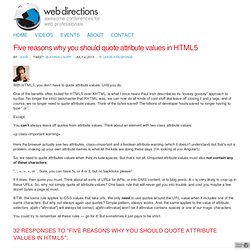
Until you do. One of the benefits often touted for HTML5 over XHTML is what I once heard Paul Irish describe as its “loosey goosey” approach to syntax. No longer the strict taskmaster that XHTML was, we can now do all kinds of cool stuff like leave off closing li and p tags, and of course, we no longer need to quote attribute values.
Think of the bytes saved! The billions of developer hours saved no longer having to type " or '. Except. Dynamic pagination. Pagination over a constantly changing list is hard.
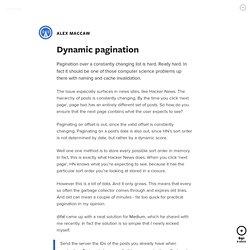
Really hard. In fact it should be one of those computer science problems up there with naming and cache invalidation. The issue especially surfaces in news sites, like Hacker News. The hierarchy of posts is constantly changing. An Introduction to Node's New Streams by Calvin French-Owen. Recently, there’s been a lot of commotion on twitter and in #node.js about the new streams2 API.
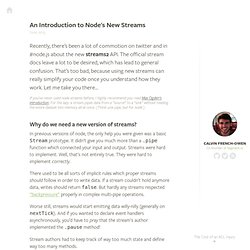
25 eye-popping examples of parallax scrolling websites. With new technologies like HTML5 and CSS3, it's becoming possible to create more advanced, interesting and remarkable effects in the browser.
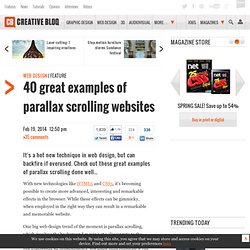
While these effects can be gimmicky, when employed in the right way they can result in a remarkable and memorable website. One big web design trend of the moment is parallax scrolling, which involves the background moving at a slower rate to the foreground, creating a 3D effect as you scroll down the page. It can sometimes be overwhelming, but when used sparingly it can provide a nice, subtle element of depth. To show how it should be done, we’ve collected together sites that employ the technique to good effect. In some cases the parallax scrolling is the star of the show; in others it simply adds a touch of depth that makes the foreground seem to pop out a little.
Also read: Build a parallax scrolling website: pro tips. 5 Reasons to Choose Opera over Chrome - Chrome vs Opera. Opera Software recently took a major decision to stop using its own rendering engine, and move to Google’s Blink engine on desktop and Android platforms.
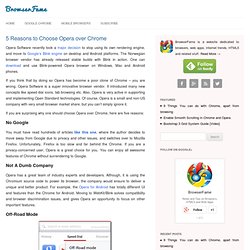
The Norwegian browser vendor has already released stable builds with Blink in action. One can download and use Blink-powered Opera browser on Windows, Mac and Android phones. If you think that by doing so Opera has become a poor clone of Chrome – you are wrong. Opera Software is a super innovative browser vendor. It introduced many new concepts like speed dial icons, tab browsing etc. Responsive Web Design Patterns. Responsive Patterns.

Why mobile web apps are slow. I’ve had an unusual number of interesting conversations spin out of my previous article documenting that mobile web apps are slow.
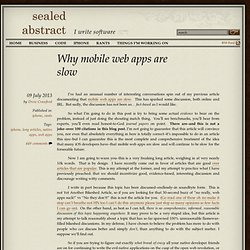
How to stop worrying about CSS vendor prefixes — Alejandro Beltrán. There are a lot of ways to start using vendor-prefixed CSS features.

The Good. HTML5 History API: A Syntax Primer. As most of us probably are aware, a significant part of the HTML5 spec is the expansion of the History API.
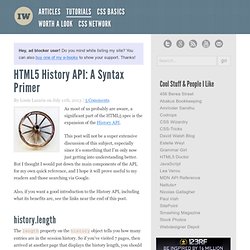
This post will not be a super extensive discussion of this subject, especially since it’s something that I’m only now just getting into understanding better. But I thought I would put down the main components of the API, for my own quick reference, and I hope it will prove useful to my readers and those searching via Google. Also, if you want a good introduction to the History API, including what its benefits are, see the links near the end of this post. history.length The length property on the history object tells you how many entries are in the session history. In defense of the humble id attribute. Recently on my post about quoting HTML5 attributes, Paul Irish commented in passing IDs are totally out of fashion now due to their high specificity so who cares This idea has been floating around for a while.
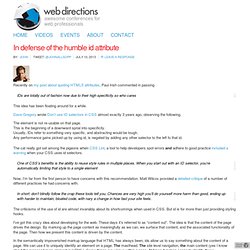
Dave Gregory wrote Don’t use ID selectors in CSS almost exactly 3 years ago, observing the following. The element is not re-usable on that page.This is the beginning of a downward sprial into specificity.Usually, IDs refer to something very specific, and abstracting would be tough.Any performance gains picked up by using id, is negated by adding any other selector to the left fo that id.
The cat really got set among the pigeons when CSS Lint, a tool to help developers spot errors and adhere to good practice included a warning when your CSS uses id selectors. The flat design trend - where to from here? — Design/UX. I’ve always subscribed to the Swiss style of less is more, so wholeheartily embracing this era of flat interface design. Given the design excesses of the past decade, it’s interesting to see how we’ve come full circle to reach this point.
But I can’t help wondering – where to from here? When I started designing websites back in the year 2000, all the world was flat. This was more by technological limitations than by choice, or possibly because we hadn’t considered there was any other way. Web 2.0 exploded in 2004, giving rise to a ‘richer’ user experience of gradients, rounded corners and 3D buttons. From here a host of web design trends emerged, first embraced, then vilified by the design community. It always surprised me how wholeheartedly Apple embraced skeuomorphism, given their clean and minimal design ethic. iBook’s faux wood bookshelf and iCal’s moleskin ‘hand-stitched’ leather binder, while initially enchanting now seem terribly passe. These changes aren’t all about fashion. Automatic Table of Contents. Any long page of content with distinct and well marked up content can benefit from a table to contents. A table of contents provides a quick way to jump down the page to the desired section.
Of course you can create a table of contents manually, but it may be smart to build it dynamically on-the-fly with JavaScript. This is true for several reasons: A comparison of Angular, Backbone, CanJS and Ember - Sebastian's Blog. Selecting a JavaScript MVC framework can be hard work. There are so many factors to consider and so many options out there that selecting a framework can be overwhelming. To have an idea of all the possible alternatives have a look at TodoMVC. I have had the opportunity to use four of these frameworks: Angular, Backbone, CanJS and Ember. Printing The Web. Hey there… This post is 398 days old. It was written on 25.03.2013. Please make sure to be careful with the information provided and check a more recent source on this topic. While it is possible to consume nearly all means of content on your smartphone or tablet it seems like the dream of a paperless office comes true for a lot of web developers.
But digital natives are not the only ones who are on the web. Disclaimer: This article was first published in the German Screen Guide Magazine #15 (September to December 2012, pages 77 to 79). The basics of a print style sheet should already be well known by most web developers. Advanced cross-browser flexbox. Crocodoc. S Den - Tweak Touch Behavior in Internet Explorer with User Style Sheets. Apr 5, 2013. Inline scripts: sometimes the web is just screwed up : Algorithms for the masses - julian m bucknall.
HTTP: The Protocol Every Web Developer Must Know – Part 1. An Event Apart: 10 Commandments of Web Design. Essential tools for every web designer. Every web designer requires the right tools to do their job. Easily center text vertically, with SVG! 10 things web designers need to know about app design. The line between a website and an app for your smartphone has blurred in recent years as HTML5 and CSS3, combined with JavaScript, has facilitated many desktop-like interactions within websites and web apps. As tools have improved, and smartphone market saturation increased, so the opportunities for web designers to use their skills to design apps.
There are two basic approaches to designing an app using your web design skills. The first is to create a web app - a mobile-orientated website in essence. Future of Firefox DevTools. Wireframing your web application. Build Simple Web UIs with the Nancy Framework. C# Corner Build Simple Web UIs with the Nancy Framework. Unsupportable Promises. Learn CSS Layout. Pete LePage on the Web » Viewport target-densitydpi support is being deprecated. A Primer to Front-end SVG Hacking. Nginx Vs Apache in AWS – Updated. Client-side MVC is not a silver bullet. Why Microsoft Is Pushing a Touch-Based Web of Tomorrow. Creating 3D worlds with HTML and CSS. Dissecting Gmail’s Email Attachments. I will miss the “Douglas Crockford of browsers” Writing modular frontend components in 2013.
Web Performance 101: An opinionated guide to the 22 links every developer should read. Why average latency is a terrible way to track website performance … and how to fix it. « Mike Volodarsky. A Peek at Internet Explorer’s Developer Tools. IE10 Snap Mode and Responsive Design. Why and how to not use hover styles on touch devices. Anatomy of HTML5/JavaScript Single Page Application in Samples (basics, navigation, composition, communications with the server) Borisyankov/DefinitelyTyped. Colorbrewer: Color Advice for Maps.
25 Cool jQuery Countdown Scripts. JavaScript LED Message Scrolling Display. 50 JavaScript Libraries for Charts and Graphs.